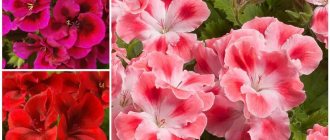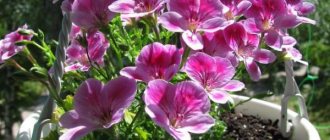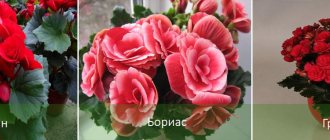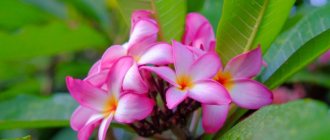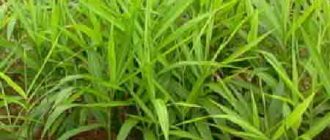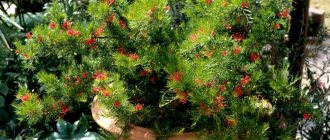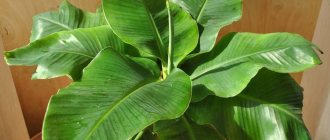Photo
Below you can see a photo of the plant.
Differences between an ivy-leaved plant and a regular one
Important.
The ampelous geranium received its name due to its well-developed, flexible, flowing shoots, the length of which can reach 90 cm. The ordinary geranium has an erect, small-sized stem. The ordinary geranium has an erect, small-sized stem.
The ampelous variety differs not only in the length of the shoots, but also in the leaves. Geranium leaves have a velvety surface, while geranium leaves have a leaf blade:
- smooth;
- dense;
- leathery.
Outwardly, it resembles an ivy leaf, which is why the plant is sometimes called “ivy-leaved pelargonium.”
Peduncles form in the axils of the leaves.
The flowers of ampelous geranium are up to 4 cm in diameter, collected in large umbrella inflorescences. Depending on the variety, the flowers can be single or double.
The color of the petals is bright and spectacular, in all shades of pink and red. Some hybrid varieties have spots and stripes of contrasting colors or borders on the petals.
Ampelous species are very popular among flower growers and landscape designers. Unlike other types, the ampel form has a number of advantages:
- care is not difficult;
- can be grown as a perennial form indoors or as an annual form in the garden;
- long flowering period from spring until the first autumn frosts;
- suitable for decorating hanging gardens;
- tolerates direct sunlight well;
- drought-resistant;
- tolerates slight drops in temperature well.
Attention. The plant has the only drawback - with high humidity, the root system and stems of geraniums rot.
The necessary conditions
When growing ivy geraniums, the following conditions must be observed:
- Lighting . The plant actively blooms and develops in bright light. Thanks to this, you can install the pot anywhere, even in direct sunlight. But lack of light and drought harm the plant.
- Temperature . In summer, the room temperature must be maintained at a temperature of at least 25 degrees, and in winter – 15 degrees. And although the plant can easily tolerate drought, frost has a detrimental effect on it.
- Humidity . Too dry air is not harmful to geranium; it does not need additional moistening or spraying. The optimal humidity is 65-70%.
Types and varieties
Currently, breeders have bred about 70 species of ivy-leaved pelargoniums. Ampelous geranium has undergone a long selection, thanks to which varieties with varied petal colors have appeared - plain and with edging (or strokes). The varieties also differ in the structure of the flower - they can be simple and symmetrical, or double and rosebud. Some varieties of ivy geranium have decorative foliage with yellow or pinkish edges, similar to ivy leaves, but stiffer.
Summer rain
Pelargonium ampelous Summer rain
Pelargonium ampelous Summer rain reaches 80-100 centimeters in length. The leaves are green and smooth and can grow up to 8 centimeters. There are 5-8 simple flowers in the umbrella. Flowering begins in May and continues until mid-autumn.
The plant is unpretentious, suitable for both indoor growing and outdoor cultivation in the summer.
Loves bright sun and moderate watering. Excessive watering and spraying will cause the plant to rot.
The soil for sowing seeds should consist of peat and sand, and for an adult plant, heavy soil with the addition of clay is suitable, since the plant’s homeland is mountainous. In winter, the temperature in the room should not fall below 10 degrees and should not exceed 15 degrees.
Can be used as a ground cover plant in summer under large trees or for flowerpots and balcony boxes.
Crystal Queen
Pelargonium Crystal Queen
Pelargonium Crystal Queen branches strongly, forming a powerful, spreading bush. Only two plants are enough for one pot. Very strong stems are resistant to winds and stretch up to 30 centimeters, forming a lush green cap, covered with white flowers during flowering. Flowering begins in May and ends in September.
For long-lasting abundant flowering, it is necessary to constantly remove faded flowers. Prefers southern and western windows when grown at home. There are pink and red hybrid varieties.
Tuscany
Geranium ampelous (ivy-leaved) Tuscany
This type of pelargonium has several varietal forms, distinguished by a variety of colors. The plant can grow up to 50 centimeters and bloom from May until the onset of frost. The flowers are semi-double, the petals are round, of different colors, the inflorescence is large, and when blooming, they form a spherical shape. The plant is cold-resistant - able to survive at temperatures around 0 degrees. During winter maintenance, it is necessary to reduce watering and lower the temperature to 10 degrees.
Planting and transplanting
Ivy geraniums need to be replanted every 2 years in the spring. Each time you replant, you need to change the pot so that it is slightly larger than the previous one. In this case, the composition of the soil should remain the same.
Procedure:
- Place drainage at the bottom of the pot. These could be broken bricks, pieces of foam.
- Remove the geranium along with the earthen lump from the old container. To facilitate this procedure, water the plant first, and when the water is absorbed, turn the pot over, holding the lump and plant with one hand, and the pot with the other.
- After removing the plant, you need to carefully examine the root system to ensure there is no damage or decay. Remove all suspicious parts with scissors so as not to touch healthy roots.
- Place the plant in a new pot, and fill the void between the walls and roots with a new and slightly moistened substrate.
- The soil near the root must be compacted well so that there are no voids.
- Water the plant with water at room temperature and place in the shade for 7 days.
- After a week, move the pot to a permanent place.
Autumn transplantation of pelargonium shoots before winter storage.
We are preparing the soil for replanting pelargonium bushes (shoots). To do this, mix peat, turf soil and sand in a ratio of 4:4:2 and fill the flowerpots, and if there is a lot of planting material, the boxes.
We cut off the tops of the shoots, leave them for green (mother) cuttings, and plant individual plants in containers and bring them into the house.
In winter, do not forget to “visit” the plants - remove yellow leaves and dead shoots. It is necessary to cut with scissors, being careful not to damage the axillary buds.
We water it rarely so that the earthen clod does not dry out. We turn the flowerpots twice a month so that the shoots grow evenly and the bushes form even and compact.
We send pelargonium to a “winter apartment” without transplanting.
In the second option: we bring the plant indoors without replanting, but only by shortening the shoots by 3-4 internodes. In February, before active growth begins, we transfer the pelargonium bushes with roots into fresh soil. If during the winter period the apical shoots grow, they need to be shortened again.
Home care
Watering and fertilizing
In summer, during the heat, geranium ivy should be watered frequently , but avoid over-watering, as stagnation of water in the pot will lead to the formation of mold. To prevent its development, it is necessary to make drainage.
When the cold weather arrives, the number of waterings is reduced to once every 2 weeks.
Important! It is not recommended to spray the leaves of ivy geranium, as getting water on them will lead to the development of diseases.
The plant responds positively to feeding. It is recommended to introduce nutrition during the flowering period, using a mixture of potassium and phosphorus. Various complex supplements are also used, in which these microelements predominate. It is good to feed geraniums with magnesium sulfate. Magnesium and sulfur contribute to the long-term formation of buds.
If the soil is too rich in nitrogen, the bushes and leaves will begin to grow actively, and flowering will become poor. It is better to fertilize once a week, while alternating mineral and organic compositions.
Pruning for lush flowering
In order for the flowering to be lush and abundant, the bush must be pruned every year . Do this in the first months of spring, immediately after winter rest, following the following recommendations:
- During the pruning process, all diseased or withered branches must be removed; only those shoots that have 2-4 nodes should be left.
- To perform pruning, you must use a sharp knife disinfected with alcohol. It is forbidden to break off or tear off the leaves, as the torn edges will rot.
- If during the pruning process a leaf is still torn off, then the breakage area must be treated with charcoal.
- Proper pruning of leaves is carried out so that the base of the cutting itself is on the plant, and not on the torn leaf.
Find out more details about caring for ivy-leaved geranium at home in a separate article.
Wintering conditions for ampelous ivy-leaved pelargonium
With the onset of autumn, pelargoniums are returned indoors, but not to warm rooms, but conditions are created for them that are close to winter in the plants’ homeland - South Africa.
- To do this, choose a bright, cool and dry place for pelargoniums.
- Provide a temperature in the range of 7–15 °C.
- Reduce watering, only moistening the soil to avoid root death.
- The leaves and stems are not moistened; fertilizing is completed a month before the start of wintering.
In the off-season, plants require practically no special care, but you should not propagate pelargonium at this time. The cuttings take root poorly, and the bushes turn out weak and elongated. If it is difficult to create a semblance of a South African winter at home, in August the apical cuttings are cut from large plants and rooted. Young plants can overwinter on cool window sills inside the house, and in the spring they can be planted on the balcony or in the garden.
Reproduction
Ivy geranium is propagated by two methods: seeds and cuttings.
Seeds
This method allows you to obtain a lot of planting material, although you can also purchase it in a specialized store. But just sowing seeds is a complex process that requires compliance with the following recommendations :
- It is necessary to sow planting material from November to April. In winter, sprouts require additional lighting.
- For the development of a strong root system, the soil must be loose and light.
- Seeds should be sown in peat pots or tablets. Seal them no deeper than 5 mm.
- Cover the container with the crops with plastic wrap.
- It is better to use a spray bottle to water the seedlings.
- 30 days after the appearance of the first shoots, you can pick and plant the plants in separate containers. From this moment on, it is necessary to fertilize the geranium.
We invite you to watch a video about planting geranium ivy seeds:
Cuttings
This method of reproduction is used most often. Let's look at how to prepare planting material and root cuttings into the ground. Procedure :
- Using a sharp knife, cut cuttings from the tops of vertical shoots. Do this in August or March.
- Choose shoots that are at least 7 cm long. They should also have 2 leaves.
- After cutting, dry the shoots for 15 hours and treat with activated carbon powder.
- Root the planting material into loose soil. You cannot deepen the cutting more than 4 cm.
- Cover the container with non-woven material that allows air to pass through well and does not form condensation.
We invite you to watch a video about cuttings of ivy-shaped geranium:
Read more about the propagation of ivy-leaved ampelous geraniums and subsequent care here.
Description of the plant
Ampelous geranium is not yet often found in vertical gardening. Its strong stems stretch up to a meter. Beautiful, dense, five-fingered leaves are similar to ivy leaves and, depending on the variety, can be plain or variegated (up to 6 centimeters in diameter). Thanks to the leaves, another name appeared for this type of geranium - ivy-leaved pelargonium. The leaves are arranged alternately.
On the upper part of the stem in the axil of the leaf, long peduncles with beautiful lush umbrella blooms appear. The corolla has a variety of colors and shapes. There are simple corollas of five petals, and complex double or rose-shaped ones. The diameter of the flower, depending on the variety, can be from 1.5 to 4 centimeters. The inflorescence itself can reach 8 centimeters in diameter and consist of 30 flowers.
The root system is fibrous, very strong, capable of supporting the plant on infertile soils in mountainous areas.
Bloom
For lush flowering, the plant needs good lighting and timely application of fertilizers. The first two or three spring feedings should contain a large amount of nitrogen. If you continue to feed the plant with such fertilizers, then flowering may not occur or will not be long and weak, and the green mass of the flower will be very lush. From the third or fourth feeding, the fertilizer should contain potassium and phosphorus to obtain early and abundant flowering.
An important condition for flowering is a small pot. When replanting a plant into a new container, you need to make sure that it is only 2-3 centimeters larger than the previous pot.
Timely spring, and especially autumn, pruning will allow the formation of flower buds. Autumn pruning should be deep and mainly on old bare stems. In spring, pinching is enough; if you cut the flower too much, you can lose the flower stalks.
Possible problems
Pests and diseases
The following diseases can affect ivy geranium:
- Botrytis mushroom . It can be distinguished by the presence of brown spots covered with gray fluff. The number of spots will gradually increase and the leaves will fall off. Excess moisture can affect the spread of the fungus.
- Root system rot . Occurs due to water stagnation and increased nitrogen concentration. Over time, the disease affects the stem, causing its color to turn brown and then black.
- Bacterial diseases caused by microorganisms . Blackening and wilting of the stem occurs.
Among the pests that pose a danger to the plant are:
- Caterpillars, slugs . These parasites feed on geranium foliage.
- Ticks . These pests thrive in hot and dry weather. You can notice the parasite by yellow spots on the leaves, as a result of which they gradually fade.
- Aphid . Curled, yellowed leaves will help identify the presence of a pest.
- Thrips . They appear in the form of corky growths on the leaves, which as a result become deformed.
Treatment
To treat a flower for these diseases, it is necessary to transplant the plant into another container, remove all affected parts, and then treat it with fungicides.
Important! As a preventive measure, you need to regularly spray the geranium and weed the soil.
There is a scheme for pest control:
- Slugs – use systemic insecticides.
- Ticks – treat with soap and mineral oil, and in case of extensive damage, use chemicals:
- Lightning;
- Detox;
- Bi-58.
- Aphid – treatment of the plant with an ash-soap solution, as well as preparations:
- Spark;
- Aktara.
- Thrips – install blue sticky traps, use the following preparations:
- Aktara;
- Biotlic.
Geranium ivy is a very beautiful plant that needs to be cared for regularly. It is enough to make a small mistake, as diseases and pests immediately attack the flower, which can then be very difficult to save.
There is an amazing variety of types and varieties of geranium - this beautiful and incredibly fragrant flower. On our website in a number of articles you can learn about the white and black varieties of geranium, about rosebud and fragrant, royal and tulip-shaped, beautiful Roberta, about the varieties Rosanna and Angel.
Diseases of ivy-leaved pelargonium
Since pelargoniums are often planted in the garden or decorate balconies in the summer, it is difficult for them to avoid fluctuations in humidity and temperature. Therefore, when seeing rusty or dry spots, light areas or a yellow mosaic pattern on the leaves, the gardener should be wary and think about the health of the plant.
Most often, ivy-leaved pelargoniums suffer from attack by harmful fungi, viral mosaic and chlorosis.
Depending on the nature of the disease, the bushes must be treated with special protective equipment, fertilizing is adjusted and the watering schedule is revised. After all, it is high humidity, lack of lighting and weak plants that are the main causes of pelargonium diseases. As a preventive measure, before planting pelargoniums, be sure to disinfect the soil and avoid excessive bush density, which interferes with ventilation and provokes the development of fungi and pests.
When loosening the soil under the plants, remove yellowed and fallen leaves, cut off wilted inflorescences and prevent the soil from becoming waterlogged.
What is the difference between ivy-leaved geranium and regular geranium?
Ivy-leaved geranium (pelargonium) belongs to the ampelous plant species that are capable of producing rather long shoots hanging down from flowerpots or curling along the wall. Regular geraniums have short shoots, large and rather fragile leaves. In ampelous geranium species, the shoots are quite strong, flexible, capable of supporting the weight of leaves and a large number of flowers. The leaves of ampelous geranium species are five-pointed, large, smooth, with a matte sheen, without fluff on the surface. In shape they are very reminiscent of ivy leaves, which love to climb along vertical surfaces.
Pelargonium ampelous (ivy-leaved)
Homemade geranium
The flowers of ivy-leaved geranium are always bright, large, and full. They are the most important decoration of the plant. Very often, flowers are collected in large inflorescences at the top of the shoot, which gives the flowering plant the appearance of a fluffy multi-colored cloud. Some plant growers plant several varieties of ivy-shaped geraniums with different flower colors nearby in one box or flower pot. This allows you to create a real extravaganza of color and unusually decorate your loggia or balcony.
Ivy-leaved pelargonium
The most popular varieties of ampelous ivy-leaved geranium. Table
| Name | Description |
| Amethyst | An ideal variety for growing on the balcony. The flowers are large, double, collected in bright inflorescences. The shoots grow quickly, forming a lush basket. The basic colors of the variety are bright crimson, purple, dark pink. |
| Crocodile | This variety is distinguished by its unusual leaf color: frequent golden veins stand out brightly on the green field. The flowers are semi-double, colored coral or purple, collected in large inflorescences. During the growing season, the plant quickly forms a compact basket. |
| Ice Rose | This variety looks like roses due to its large double inflorescences. The petals of the flowers of this variety of geranium are white. The plant forms a compact bush, which is abundantly strewn with beautiful white flowers. |
| Jacky Gauld | Another variety that amazes with its abundant flowering. The flowers are white, double, with many petals. The bushes are large due to the abundant branching of the shoots. The highlight of this variety is that in open sunlight the snow-white petals over time acquire a pink or purple tint, which looks very unusual. |
| Mrs.Martin | This variety amazes with its abundant flowering and beauty. Large double flowers are always collected in large inflorescences. When flowering, the geranium bush looks like a lacy cloud, which can be pink or light lilac. The plants are unpretentious and are characterized by rapid branching of shoots and the formation of a large basket. |
| Rouletta | The flowers of this variety have a bright and unusual color: large white petals are surrounded by a rich crimson border. This variety of geranium is classified as compact, since the height of the bush does not exceed 25-30 cm. It blooms very profusely and is unpretentious to watering. |
| Tornado Lilac | The variety is distinguished by a compact bush, which is densely dotted with bright purple flowers. The upper petals of each flower are decorated with purple veins. The variety is distinguished by its prolific flowering even in winter and is unpretentious. |
| Rhapsody | This variety is distinguished by very large and large flowers, the upper petals of which have a more intense color than the lower ones. Most often, the flowers of this variety are painted in a rich burgundy color. It is distinguished by abundant flowering; the bushes are large with wide glossy leaves and branched shoots. |
| PAC Red Sybil | The flowers of this variety of geranium are bright red, very large, with large petals. The bush is quite compact, not too tall. The leaves are green, without spotting, the internodes on the shoots are short. |
| RAS Tomcat | The flower petals of this variety have the most saturated color among all types of geraniums - dark burgundy. The variety is distinguished by abundant flowering; the bush forms a compact lush basket. The leaves are green, with a glossy sheen. no spotting. |
Ampelous geranium - types, description
Externally, the flowers of ampelous geranium resemble peonies. Flowering lasts a long time, starting in spring and ending in late autumn. The flowers have a rich range of colors, not only blue and bright yellow, you can often find:
- Scarlet;
- White;
- Lilac;
- Pink;
- Reds.
The flower should always be located in a well-lit room, otherwise it will have limp stems with pale leaves
This species is rarely found in vertical gardening. Pelargonium ampelous is more suitable for hanging gardens. This is where the name climbing geranium comes from. The main feature of ampelous geranium is its flexible shoots, which can reach a length of 90 cm. They can hang and curl beautifully. In nature, geranium is a perennial shrub that grows in mountainous areas. In addition to its attractive appearance, the plant is distinguished by its endurance.
This type of pelargonium is called ivy-leaved, due to the special structure of the leaves, whose shape resembles ivy leaves. The leaves are very hard to the touch that even some people mistake them for artificial ones, but this is not so.
Important! The leaves of this species of geranium are glossy, and not covered with fluff, like those of its closest relative - zonal Pelargonium. Chandelier geranium does not need special care at home, since in nature it grows in mountainous areas
A well-lit loggia or window sill is sufficient. When growing seedlings, do not get too carried away with watering, otherwise the plant may die. In summer, it is recommended to water, feed and pinch geraniums.
Chandelier geranium does not require special care at home, since in nature it grows in mountainous areas. A well-lit loggia or window sill is sufficient. When growing seedlings, do not get too carried away with watering, otherwise the plant may die. In the summer, it is recommended to water, feed and pinch geraniums.
Note! Pelargonium can be grown either from cuttings from an adult plant or using seeds. If you overdo it with watering in winter, it will be the main cause of disease and poor roots in the plant.
Ivy geranium: care and propagation
In order for a plant to grow and develop normally, you need to know certain rules. Ivy geranium is almost always accepted. There are several secrets that will help keep geraniums from drying out and falling leaves, so that the indoor plant blooms and grows in size. Caring for this type of plant is completely identical to that present in garden crops.
Ivy-leaved ampelous geranium care and propagation requires the following:
- In order for ivy-leaved pelargonium to feel good, you need to prepare a special soil. The following components should be present in equal proportions: peat, sand, turf and leaf soil;
- in summer you need to water geraniums 2 times a day. You need to use water at room temperature. The soil should be treated with a spray bottle;
- Periodically you need to trim the flower bushes, removing the lower branches. The result should be a mini-tree with a profusely flowering crown;
- Before winter, it is necessary to trim all shoots except the central one, which has no more than 6 leaves.
Caring for geranium seedlings
For your information! The main condition is frequency of actions. Don’t forget about watering, trimming branches, and sometimes fertilizing the soil. Caring for ivy-leaved pelargonium is not difficult if you follow these rules.
Growing from seeds
Geranium can be propagated from seeds. Germination of planting material occurs within 1-2 weeks under normal conditions. In order for the seedlings to germinate accurately and be strong, you need to take into account several nuances:
- choose quality planting material. Each seed should be brown. Each specimen should be firm and slightly oblong;
- seed preparation. If the material is purchased, then there will be no problems with this, since the seeds have already been processed. Homemade specimens need to be sanded with sandpaper, treated with special products and soaked in water;
- prepare loose soil, which should have the appropriate composition. It is better to buy ready-made in an agricultural store;
- select containers for sowing. You need to choose flowerpots that are not too tall. This will make it easier to root the plant;
- how to sow: lay out drainage at the bottom, fill in the soil, and then the seeds at a distance of 5 cm from each other, sprinkle them with 2 cm of soil and spray with a spray bottle. After this, place the flowerpot on the windowsill and cover with glass.
Growing geraniums from seeds
Note! It is better to purchase planting material from a specialized store. The purchase will cost more, but the quality will be 100%
The growing process itself is simple: moisten the soil according to need, open the glass for a few minutes a day. After the first shoots appear, standard care is carried out as for ordinary seedlings.
Propagation of ampelous geranium by cuttings at home
Geranium can also reproduce by planting cuttings. This option is relevant for beginning gardeners. It is better to take cuttings in the spring. At this moment, not only the shoots are split off, but also the plant is cultivated. If there is no need to trim excess branches, then you can pinch off the cuttings in autumn or winter.
First you need to correctly cut the branch, which will later become a shoot. Cuttings of ampelous pelargonium are carried out in accordance with the following algorithm:
- Select a branch. The length of the shoot should be 10-12 cm and have at least 5 leaves.
- The cuttings are being prepared. After splitting, treat the cut with a special agent. Place on paper to let the twig dry. 6 hours is enough.
- Prepare the soil by pouring it into a container. Drainage should already be formed at the bottom of the container before this.
- Bury each branch by 1-1.5 cm. Compact the soil around the trunk well.
- Moisten the soil with a spray bottle.
Propagation by cuttings
Note! The cuttings should not be placed in water. The twig will not sprout roots, but will simply rot
The seedling will take root in 2-3 weeks. During this time, 1-2 leaves may turn yellow and fall off. If the trunk begins to dry out, the plant is receiving too much moisture.
Growing from seeds
It is possible to grow pelargonium ivy from seeds, but hybrid plants cannot be obtained from seeds. The Tornado and Summer Showers series are two varieties that are offered as seed. In plant species, you can collect fuzzy seeds after the blooms have faded. Sow them indoors in January in a sterile starting mixture and press lightly into the soil. The seeds germinate in about a week at 20 degrees and reach flowering size in about three months.
